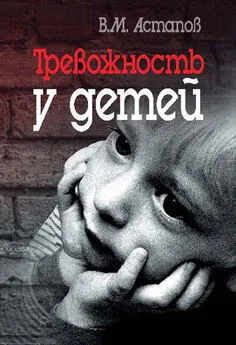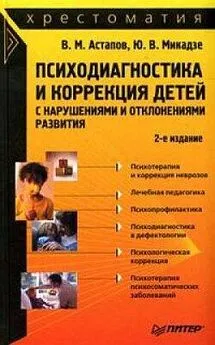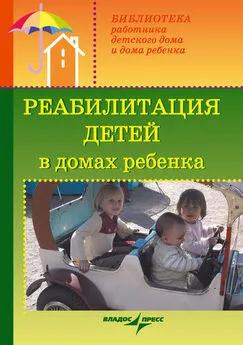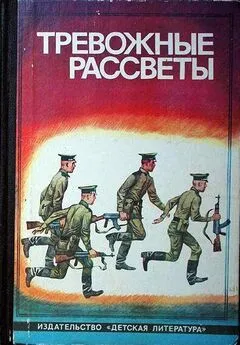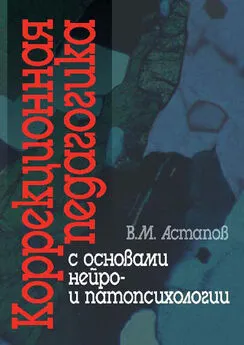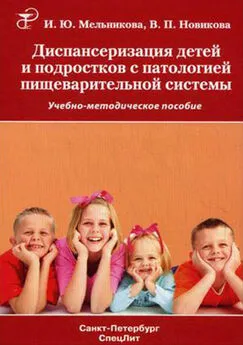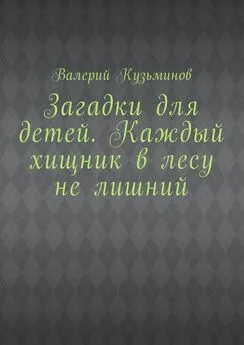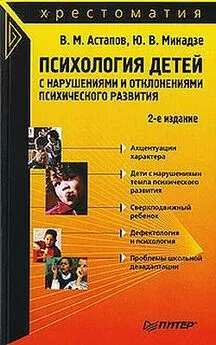Валерий Астапов - Тревожность у детей
- Название:Тревожность у детей
- Автор:
- Жанр:
- Издательство:Литагент «Когито-Центр»881f530e-013a-102c-99a2-0288a49f2f10
- Год:2008
- Город:Москва
- ISBN:978-5-9292-0169-1
- Рейтинг:
- Избранное:Добавить в избранное
-
Отзывы:
-
Ваша оценка:
Валерий Астапов - Тревожность у детей краткое содержание
Книга посвящена анализу места и роли тревоги в аффективных и поведенческих расстройствах у детей. Рассмотрены теоретические вопросы, касающиеся источников, причин и особенностей проявлений тревоги в детском возрасте, а также анализируются клинические и научные исследования тревожных расстройств, представленных в международных классификациях болезней. Предлагаются некоторые способы преодоления тревоги.
Книга рассчитана на практических и медицинских психологов, а также будет полезна детским врачам-психоневрологам и психотерапевтам.
Тревожность у детей - читать онлайн бесплатно ознакомительный отрывок
Интервал:
Закладка:
85. Dowrick P., Raeburn J. Video editing and medication to produce a therapeutic self model. – J. Consulting and Clinical Psychology, 1977, Vol. 45, pp. 1156–1158.
86. Durand-Dassier J. Structure et psychilogie de relation. Paris, L’Epi, 1969.
87. Dweck C., Worthman C. Learned helplessness, anxiety and achievement. – In: H.Krone, L.Laux (Eds) Achievement, stress and anxiety. New York, 1982, pp. 93-125.
88. Endler N., Hunt J., Rosenstein A. An S-R inventory of anxiousness. – J. Psychol. Monogr., 1974, Vol. 76, pp. 145–162.
89. Epstein S. The nature of anxiety with emphasis upon its relationship to expectancy – In: Anxiety, current trends in thory and research, vol. 2 / Ed. Ch. Spielberger. New York – London, 1972, p.291.
90. Epstein S. Toward a unified theory of anxiety – In: Progress in Experimental Personality Research / Ed. B.Macher. – New York, 1967, pp. 1-87.
91. Evers W., Schwazz J. Modifying Social withdrawal in preschoolers: The effects of filmed modeling and teacher praise. – J. Abnorm. Child Psychology, 1973, Vol. 1, pp. 248–256.
92. Eysenck H. The Structure of Human Personality. London, 1953, 348 p.
93. Eysenk H. A genetic model of anxiety – In: Stress and Anxiety, Vol. 2 / Eds. Z.Sarason, Ch.Spielberger – Washington, 1975, pp. 81-116.
94. Eysenk H. The biological basis of personality. Thomas Springfield, 1967.
95. Eysenk M. Cognitive factors in clinical anxiety: Potential relevance to therapy – In: New Concepts in Anxiety / Eds. M.Briley, S.File – CRH Press, 1991, pp. 418–433.
96. Eysenk S. Anxiety and the natural history of neurosis. – In: Stress and anxiety. Vol.1 / Eds. Ch. Spielberger, J. Sarason. New York, 1975, p.51.
97. Ferenczi S. Confusion to tongues between the adult and the child. – Int. J. Psychoanal., 1949, Vol. 30, pp. 225–241.
98. Flavell J. The Developmental Psychology of Jean Piaget, Van Nostrand, New Jersey, 1963, c.132–285.
99. Flescher J. A dualistic viewpoint on anxiety. – J. Amer. Psychoanal. Ass., vol.3, p.415, 1955.
100. Francis G. The role of anxiety and depression in socially withdrawn children. – Virginia Polytechnic Institute and State University, Blacksburg, 1986.
101. Francis G., Last C., Strauss C. Avoident disorders and social phobia in children and adolescence. – J. Amer. Acad. Child and Adolescent Psychiatry, 1992, Vol. 31, pp. 1086–1089.
102. Freud S. Hemmung, Symptom und Angst, 1926.
103. Freud S. Inhibitions, Symptoms and Anxiety. Hogarth Press, 1926.
104. Freud S. The Problem of Anxiety. Norton, N-Y, 1936.
105. Freud S., Breur J. Ober Die Berechting von der Neuasthenia einen bestimmten Symptomen Komplex als “Angstneurose” abzutvennen // G.W.Bd 1, 1895, S.315.
106. Fuster J. The Prefrontal Cortex.– New York, Raven Press, 1989.
107. Fyer A., Mannuzza S., Chapman T. e.a. Specificity in familial aggregation of phobic disorders. – J. Arch. Gen. Psychiatry, 1995. Vol. 52, pp. 564–573.
108. Garre W. Basic Anxiety. N-Y: Philosophical Library, 1962.
109. Gelfand D. Social withdrawal and negative emotional states: Behavior therapy. – In: B. Wolman, J. Egan and A. Ross (Eds), Handbook of Treatment of Mental Disorders in Childhood and Adolescence. Prentice Hall, Englewood Cliffs, New York, 1978, pp. 330–353.
110. Geller S. Praca psychoterapeutyczne z rodzina. – Psychologia Wychwawcza, 1973, nr.1.
111. Gellhorn E. The neurophysiological basis of anxiety: A hypothesis. – J. Perspect. Biol. Med., 1965, vol. 8, pp.488–515.
112. Gittelman-Klein R., Klein D. School phobia: Diagnostic considerations in the imipramine effects. – J. Nerv. Ment. Dis., 1973, Vol. 156, pp. 199–215.
113. Glennon B., Weisz J. An observational approach to the assessment of anxiety in young children. – J. Consulting and Clinical Psychology, 1978, Vol. 46, pp. 1246–1257.
114. Goldstein K. Anxiety and Therapy. New York: Grune & Stratton, 1957.
115. Goldstein K. The Organism: A Holistic approach to Biology. New York: American Book Co., 1939.
116. Goldstein K. The Structure of Anxiety. Amer. J. Psychother. Vol. 8, 1954, p.745.
117. Graig K., Dobson K. Anxiety and depression in adults and children. – Int. Educational and Professional Publisher, 1995.
118. Gray J. Anxiety and personality – In: Handbook of Anxiety, Vol. 1 / Eds. M. Roth, R. Noyes, G. Burrows – New York, 1988, pp.231–257.
119. Gray J. Psychology of Fear and Stress, 2 Ed., Cambridge University Press, Cambridge, 1987.
120. Gray J. The neuropsychology of anxiety – Br. J. Psychol., 1978, Vol. 69, p.417.
121. Graziano A., De Giovanni I. The clinical significance of childhood phobias: A note on the proportion of children’s fears. – J. Behav. Res. Ther., 1979, Vol. 17, pp. 161–162.
122. Graziano A., De Giovanni I., Garcia K. Behavioral treatment of children’s fears. – A review. Psychol. Bull., 1979, Vol. 86, pp. 804–830.
123. Grinker R. A Theoretical and Experimental Approach to Problems of Anxiety. In Progress in Psychotherapy. Vol. II, 1957.
124. Grinker R. Psychosomatic approach to anxiety – Amer. J. Psychiat., 1956, vol. 113, p. 443.
125. Grinker R. Psychosomatic research. New York: Norton, 1953.
126. Grinker R., Robbins F. Psychosomatic Case Book – N-Y: McGraw-Hill, 1954.
127. Hamilton M. The assessment of anxiety states of rating. – Brit. J. med. Psychol., 1959, vol.32, p.50.
128. Herjianic B., Reich W. Development of a structured psychiatric interview: Agreement between child and parent on individual symptoms. – J. Abnorm. Child Psychology, 1982, Vol. 10, pp. 307–324.
129. Hersen M. The behavioral treatment of school phobia – J. Nerv. Ment. Dis., 1971, Vol. 153, pp. 99-107.
130. Hochmann G. Some effects of spinal cord lesions on experienced emotional feelings – J. Psychophysiology, 1966, vol. 3, pp. 143–156.
131. Hodges K. The Child Assessment Schedule. Duke University, 1982.
132. Hodges K., McKnew D., Cytryn L., Stern L., Kline J. The Child Assessment Schedule (CAS) Diagnostic Interview: A report on reliability and validity. – J. American Academy of Child Psychiatry, 1982, Vol. 21, pp. 468–473.
133. Hoehn – Saric R. Characteristics of chronic patients – In: Anxiety. New Research and Changing Concepts / Eds. D.Klein, J.Rabkin – New York, 1981, pp.39409.
134. Hoehn-Saric R. Anxiety: Normal and abnormal. J. Psychiat. Ann., 1979, vol. 9, pp.11–24.
135. Hoehn-Saric R., McLeod D. Somatic manifestations of normal and pathological anxiety. – In: Biology of anxiety Disorders / Eds. R. Hoehn-Saric and D. McLeod – Washington, 1993, pp. 177–222.
136. Hoehn-Saric R., McLeod D. The peripheral sympathetic nervous system: Its role in normal and pathologic anxiety. – J. Psychiat. Clin. N. Am., 1988, vol. 11, pp. 375–386.
137. Horney K. New Ways in Psychoanalysis. New York: Norton, 1939.
138. Horney K. Our inner conflicts. New York, 1945.
139. Hubert W., de Jong-Meyer R. Saliva cortisol responses to unpleasant film stimuli differ between high and low trait anxious subjects – J. Neuropsychobiology, 1992, vol.25, pp. 115–120.
140. Hull C. Principles of behavior. An introduction of behavior theory. New York, 1943.
141. Ingram R., Kendall P. The cognitive side of anxiety – J. Cognitive ther. Res., 1987, vol. 11, pp. 523–536.
142. Izard C., Tomkins S. Affects and behavior: anxiety as a negative affect. – In: Anxiety and Behavior / Ed. Ch. Spielberger. New York – London: Acad. Press, 1966, p.81.
143. James W. Psychology (Briefer Course). Collier – McMillan, Canada, 1962.
144. Janet P. L’Automatisme psychologique. Paris, Felux Alcan, 1910.
145. Jones E. Fear, guilt and hate. Int. J. Psychoanal., 1929, vol.10, p.383.
146. Jung C. Psychologische Types. Zurich-Stuttgart. Rascer, 1960.
147. Kardiner A., Karush A. and Ovesey L. The structural hypothesis, the problem of anxiety and post-Freudian ego psychology. – J. Ment. Dis., vol. 129, p. 341, 1959.
148. Katz E., Kellerman J., Siegel S. Behavioral distress in children with canger undergoing medical procedures: Developmental considerations. – J. Consulting and Clinical Psychology, 1980, Vol. 48, pp. 356–365.
149. Kaufer F., Karoly P., Newman A. Reduction of children’s fear of the dark by competence related and situational threat-related verbal cues. – J. Consulting and Clinical Psychology, 1975, Vol. 43, pp. 251–258.
150. Kein M. A Contribution to the theory of anxiety guilt. – Int. J. Psychoanal., 1948, vol.29, p. 114.
151. Kelman H. A unitary theory of anxiety. – Amer. J. Psychoanal., 1957, vol. 17, p.2.
152. Kendall P. Introduction to special section: Comorbidity and treatment implications. – J. Consulting and Clinical Psychology, 1992, Vol. 60, pp. 833–835.
153. Kendall P., Cantwell D., Kazdin A. Depression in children and adolescents: Assessment issues and recommendations. – J. Cognitive Therapy and Research, 1989, Vol. 13, pp. 109–146.
154. Kendall P., Watson D. (Eds) Anxiety and depression: Distinctive and overlapping features. New York, 1990.
155. Kendler K. Symptoms of anxiety and depression in a volunteer twin population – J. Arch. Gen. Psychiat., 1986, Vol.43, pp.213–221.
156. Kendler K., Neale M., Kessler e.a. The genetic epidemiology of phobias in women: The interrelationship of agoraphobia, social phobia, situational phobia and simple phobia. – J. Arch. Gen. Psychiatry, 1992. Vol. 49, pp. 273–281.
157. Kendler K., Neale M., Kessler R., Heath A., Eaves L. Major depression and generalized anxiety disorders: Some genes, (partly) different environment? – J. Archives of General Psychiatry, 1992, Vol. 49, pp. 716–722.
158. Kennedy W. School phobia: Rapid treatment of fifty cases. – J. Abnorm. Psychol., 1965, Vol. 70, pp. 285–289.
159. Klaus M. Human behavior following delivery: Is this species specific? In: M.Hofer and R. Porter (Eds), The Parent – Infant Interaction, Amsterdam, 1975.
160. Klein M. A contribution to the theory of anxiety and guilt.-J. Psychoanal., 1948, Vol. 29, pp. 114–148.
161. Klein M. The Psychoanalysis of Children. Hogarth Press, London, 1948.
162. Klerman G. Approaches to the phenomena of comorbidity. – In: J.Maser, C. Cloninger (Eds). Comorbidity of mood and anxiety disorders. Washington, 1990.
163. Knott J., Irvin D. Anxiety, stress and the contingent negative variation – J. Arch. Gen. Psychiatry, 1973, vol. 29, p.538.
164. Kovac M., Gatsonis C., Paulauskas S., Richards C. Depressive disorders in childhood. – J. Archives of General Psychiatry, 1989, Vol. 46, pp. 776–782.
165. Kovacs M. Interview Schedule for Children. University of Pittsburg, 1978.
166. Kraepelin E. Psychiatrie. Johann A. Barth, Leipzig, 1915.
167. Kubie C. The ontogeny of anxiety – J. Psychoanal. Rev., vol. 28, 1941, p.78.
168. Lang P., Bradley M., Cuthbert B. Emotions, attention and the start reflex. – J. Psychol. Rev., 1990, vol. 97, pp. 377–395.
169. Lang P., Lazovik A. Experimental desensitization of a phobia. – J. Abnorm. and Social Psychology, 1963, Vol. 66, pp. 519–525.
170. Last C., Perrin S., Hersen M., Kardin A. DSM-III-R anxiety disorders in children: Sociodemographic and clinical characteristics. – J. Amer. Acad. Child and Adolescent Psychiatry. 1992, Vol. 31, pp. 1070–1076.
171. Last C., Strauss C., Francis G. Comorbidity among childhood anxiety disorders. – J. Nervous and Mental Disorders, 1987, Vol. 175, pp. 726–730.
172. Lazarus R., Averill J. Emotion and Cognition: with special reference to anxiety – In: Anxiety. Current trends in theory and research. Vol.2/ Ed. Ch.Spielberger – New York – London, 1972, p.343.
Читать дальшеИнтервал:
Закладка:
